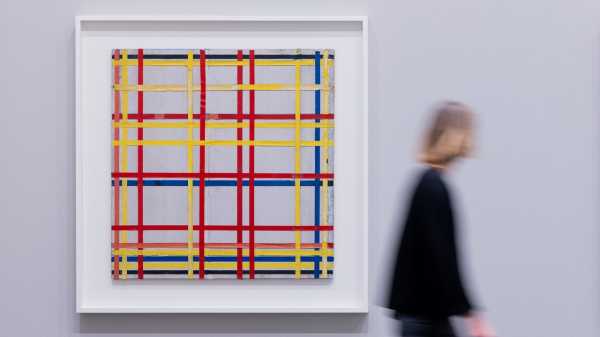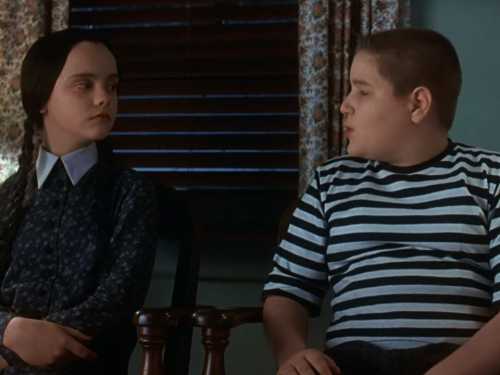
The recent discovery that a picture by the Dutch (and, latterly, New York) painter Piet Mondrian has been hanging upside down in the German museum where it has lived for half a century seemed to evoke, nostalgically, an earlier and more predictable era in the polemics of museums and modernism. “Ha, ha! You see?” the wags used to mutter on these occasions. “They can’t even tell which way is up!” And the defenders would feebly mutter fixed avant-gardisms in return. At a time when the fashionable art world has gone all in for the weirder shores of grotesque or cartoonish realism, from John Currin to Takashi Murakami, a mixup about an abstract picture made of lines and blocks of colors has a nicely old-fashioned feeling.
The Mondrian, long seen at the intimidatingly named Kunstsammlung Nordrhein-Westfalen K20, is one of the painter’s “adhesive tape” pictures—its bright red, yellow, and blue stripes laid down with sticky tape. The evidence of the hanging error, if error it is, derives from a photograph of the picture taken of Mondrian’s studio in the nineteen-forties, and from the different, seemingly more convincing, orientation of a sister painting at the Beaubourg, in Paris.
The Mondrian is doubly potent for us now, since it is called, of all things, “New York City 1,” and comes from the artist’s blissful New York period, which also produced the masterly “Broadway Boogie Woogie” and the “Victory Boogie Woogie” (once owned by Si Newhouse, Jr., once the owner of this magazine). Mondrian’s discovery of New York was one of the happiest events in twentieth-century art, albeit triggered by his forced immigration to the United States at the time of the Second World War, along with so many other European modernists. For the city revealed to him with blinding beauty that the reduced, minimal language of esoteric mysticism that he had evolved in Paris—painting reduced to nothing but three primary colors (red, blue, and yellow) and articulated only in right angles and black lines—was the perfect language of representation, the ideal abstract net in which to catch the energy and spirit of nineteen-forties New York, with its subway epiphanies and blinking traffic lights and angular bumps and just-off-the-grid zip-around rhythms. Mondrian saw New York through the prism of his own inventions, which turned out to look more like New York than any photograph could. He had seen the city in his studio.
The controversy over the upside-down Mondrian arrives at a moment when other, not quite companion, controversies about the uses and abuses of art works and the museums in which they sit have been roiling around. A squadron of loosely organized climate-change activists has been entering museums to trash famous pictures, including at least one by Mondrian’s hero, Vincent van Gogh: the activists splash the glass-covered surfaces of an image with canned soup and yellow paint, in order to dramatize the urgency of their issue; they then glue themselves to the walls of the institution, making their removal in itself a subsidiary event.
It would be nice to say that these kinds of stunts are ineffective, but, as amply documented recently in the case of Samuel Adams and his Tea Party, publicity stunts, even stupid ones, do set the stage for political ferment. They work. (This is demonstrated by the truth that we are all talking about it here.) These museum stunts are, however, particularly stupid, both in the arrogance of the assaults and in the foolishness of the targets chosen. Works of art in museums are easy targets because they are undefended, and, in the wake of these protests, they will have to be made ever more defended, compelling prudent museums to put glass on all its most famous pictures, and so helping to ruin the experience for the rest of us. Going to museums is one of the last sources of unmediated pleasure for ordinary people: there need not be guides, security barriers, or overly watchful guards. The purpose of protests of this sort, even of a nonviolent kind, is always to hijack some unsecured object or place in order to draw attention to a cause, and its result is always to make the experience of the object hijacked more miserable for ordinary people
In any case, the real value of the art assaulted is that it bears witness to exactly the kind of empathetic emotions that the protesters presumably want to inspire. In the particular case of van Gogh, no human being in the forty thousand years of humanity has ever been more inspired to ecstasy by experienced nature, and none has ever been a humbler companion in the struggles of ordinary people or inclined to ennoble them in art. If the protesters wanted to fall to their knees in reverence before a van Gogh, and then glue their hands to the floor, they might have a cause to make and recruits to add. Making van Gogh the enemy—and no amount of high-stepping rhetoric can make an assault on his pictures somehow apart from an assault on him—is nuts. Protest is a fine and essential thing, but to be constantly making enemies out of potential friends is the opposite of political wisdom, which turns on making friends out of potential enemies. (Sam Adams, after igniting the Boston Tea Party, went to patient work making a continental coalition.)
Museums are indeed the churches of progressive-minded people, since they celebrate just the qualities that fanatics and dogmatists want to quelch: the vigorous acceptance of uncertainty that lets us ask new questions and leaves us unsure about which way is up. Not knowing which way is up is indeed part of the point. “If I turn the work around, I risk destroying it,” the curator in charge of the exhibition where the Mondrian was to be shown said, according to the German publication Monopol, adding that “maybe there is no right or wrong orientation at all?” This does sound a bit like the-dog-ate-my-direction excuse-making, and one knows that there will be countless curators now sheepishly peering at their own Mondrians, checking for signs of incipient upside downness. But there is more than a little meaning in it. As our own much-to-be-mourned Peter Schjeldahl wrote, in one of his last and most passionate pieces, Mondrian’s aim “was not to create masterpieces, though he did that, too. It was ‘to find things out.’ He reduced painting’s uses and procedures, the whats and the hows, to a rock-bottom why.” Abstract art was meant to interrogate premises as much as to instill pleasures, and if one of the premises accidentally interrogated is the foundational one of up and down, well, worse things can happen to our eyes and minds.
The reason that pictures of Mondrian’s kind are inestimably precious to the human spirit, even if sporadically overpriced, is that they are the last place where individual purpose and human pluralism are so ferociously honored. The values that are most important—and ones which progressives are most inclined to honor—are those which empower the greatest range of people to self-expression with the greatest possible individuality. Uncertainty about an artist’s intentions—including, but not limited to, which way she intended the picture to be top and which bottom—is not a sign of what a certain man would call a “hoax”; it is a sign of originality of purpose and a tolerance for open-ended inquiry. There is an anarchic edge and deliberate multivalence of expression even in the most geometric and minimal kinds of abstract painting. All its meaning lies in the multiplicity of our experience.
So let us keep Mondrian evocative and right side up when we can, but relish him upside down when we must; the world turned upside down is, as students of American history and fans of “Hamilton” know, sometimes the world made right. A semi-serious, semi-modest proposal: Why not, as an act of effective protest on behalf of the planet, turn every picture in our museums upside down for a day? It would require no vandalism, much less symbolic vandalism, of their surfaces, and those who prefer the old way can look upright, whereas those who like the new way can twiddle their eyes and see freshly: our eyes, newly challenged, would be newly cleansed. Everything would be stranger than we know.
The entire controversy puts one in mind of Ludwig Wittgenstein’s wondering why people said that it was natural for humans to think that the Sun went round the Earth—what would they have thought it looked like if it were the other way round? Well, it does go the other way round, and we still struggle to see it so. Foundational interrogations are always valuable. “This side up!” the crate that the picture is packed in insists. “Which way is ‘down’?” the painting on the wall asks. It’s how we know it’s art. ♦
Sourse: newyorker.com






